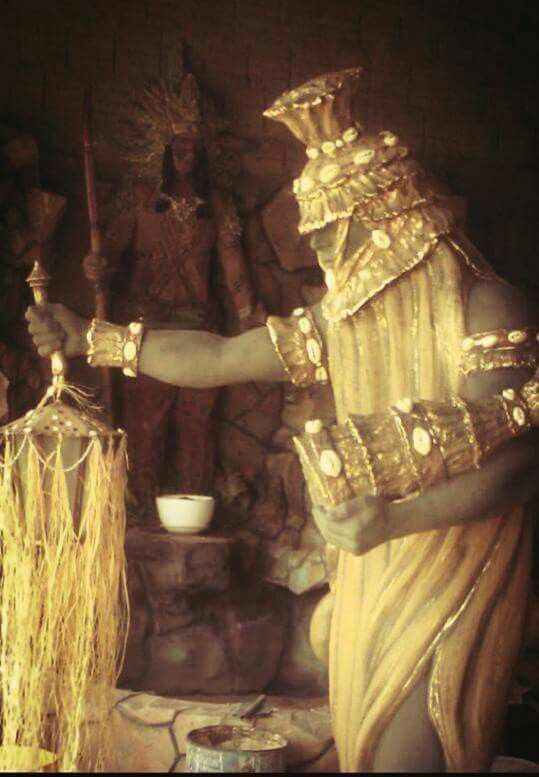Santeria is a religion of the Yoruba nation of Nigeria in West Africa. Slaves who were brought to Cuba to work in the sugar plantations. These slaves brought their spiritual traditions with them. When they were forced by their owners to convert Catholicism, they concealed their religious following within the imagery of their Catholic Saints. Santeria, also known as the “Way of the Saints,” is the term applied to slaves, who worshiped their “primitive” Saints to the detriment of the Catholic Saints. This religion is also known as”La Regla de Ocha”They have a complete theology.
Following are some core of Santeria belief.
GOD
Santeria believe in a God, Olodumare (also called Olorun or Olofi), the Creator of the universe. God is so great, and he is unrecognizable, and direct communication to the God is not possible. Humans can communicate with God through the Orishas.
ORISHAS
Orishas are the personification of all aspects of nature (oceans, rivers, mountains, thunder, rain, iron) and all human attributes (such as intelligence, caring, love, sexuality, aggression, cleverness). The universe is a composite of all the natural manifestations of the Orishas, and humans are a composite of all their personal traits. Humans often have more personality traits than others, and so people speak of an intellectual type as a “son of Obatala,” or a graceful woman as a “daughter of Ochun.” Finally, the goal of life is to be in balance with all aspects of personality and nature, to fulfill your personal destiny.
The Santeros can communicate with the Orishas in two ways: through the Ita or consultation with the Búzios, and through the physical possession of a person by his orixá. the purpose of life is to be in balance with all aspects of personality and nature in order to fulfill your personal destiny. The Santeros call upon all Orishas at one time or another to help them in this process. The Santeros can communicate with the Orishas in two ways: through the Ita or consultation with the Búzios, and through the physical possession of a person by his orixá.
Terms used in Santeria.
Lemanja: goddess of the seas and fertility, syncretized as the Virgin Mary, or Virgen de Regia, in Cuba.
Ikole orun: The “sky” where all humans go after they die. But the bad guys live a hell on Earth and suffer in the ikole orun.
Obatala: God who created life and the human consciousness of the elements of the Earth. Ogun: patron of miners and workers, adored as “Saint” Peter.
Olodumare: the supreme being who created the Universe.
Orumila: God who decides the fate of the person.
Oshun: Goddess of rivers, love, marriage, money, joy, abundance, syncretized the Virgen de la Caridad; patron saint of Cuba.
Xango: god of thunder, fire and lightning and also patron of artillery, syncretized as “Santa” Barbara in Catholicism.
Santería, also known as Regla de Ocha or Lucumí, is an Afro-Caribbean religion that originated in West Africa, and was developed in the Caribbean by enslaved African people. It’s a complex and rich spiritual tradition with various deities, rituals, and beliefs. Here’s a tabular guide to some key aspects of Santería:
| Element | Description |
|---|---|
| Deities (Orishas) | Santería has a pantheon of deities known as Orishas, each with unique attributes and responsibilities. Common Orishas include: Eleguá (gatekeeper, opportunity), Yemayá (motherhood, the sea), Oshún (love, fertility), and Changó (justice, lightning). |
| Rituals | Rituals are a core component, involving music, dance, animal sacrifice, and offerings to the Orishas. Initiation rituals are significant, often requiring elaborate ceremonies and a period of seclusion. |
| Divination | Divination is practiced using various methods like cowrie-shell readings (Dilogún) or Ifá divination, to communicate with Orishas and seek guidance. |
| Ancestor Worship | Ancestors are revered and considered important spiritual guides and protectors in Santería. Offerings and prayers are made to honor them. |
| Syncretism | Santería blends elements from Roman Catholicism and Yoruba beliefs. Many Orishas are syncretized with Catholic saints. For example, Saint Barbara is identified with Changó. |
| Healing | Spiritual healing is integral, often involving herbal remedies, spiritual baths, and prayers. |
| Community | Community is essential, with rituals and ceremonies often performed in communal settings, under the guidance of a priest or priestess. |
Understanding Santería requires a deep appreciation of its cultural and historical context, as well as its spiritual significance. This guide provides just a snapshot of its rich and multifaceted nature.
